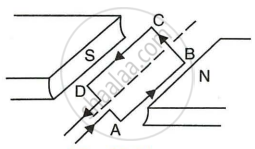Advertisements
Advertisements
Question
What type of core should be put inside a current-carrying solenoid to make an electromagnet?
Solution
A soft iron rod should be put inside a current-carrying solenoid to make an electromagnet.
APPEARS IN
RELATED QUESTIONS
Which of the following property of a proton can change while it moves freely in a magnetic field? (There may be more than one correct answer.)
Name any two factors on which the strength of magnetic field produced by a current-carrying solenoid depends. How does it depend on these factors?
A current-carrying conductor is held in exactly vertical direction. In order to produce a clockwise magnetic field around the conductor, the current should passed in the conductor:
(a) from top towards bottom
(b) from left towards right
(c) from bottom towards top
(d) from right towards left
Name one device whose working depends on the force exerted on a current-carrying coil placed in a magnetic field.
State Fleming's left-hand rule. Explain it with the help of labelled diagrams.
The force exerted on a current-carrying wire placed in a magnetic field is zero when the angle between the wire and the direction of magnetic field is:
45°
60°
90°
180°
What is the force on a current-carrying wire that is parallel to a magnetic field? Give reason for your answer.
force experienced by a current-carrying straight conductor placed in a magnetic field which is perpendicular to it.
A coil ABCD mounted on an axle is placed between the poles N and S of a permanent magnet as shown in Figure.

- In which direction will the coil begin to rotate when current is passed through the coil in direction ABCD by connecting a battery at the ends A and D of the coil?
- Why is a commutator necessary for continuous rotation of the coil?
- Complete the diagram with commutator, etc. for the flow of current in the coil?
Describe the activity that shows that a current-carrying conductor experiences a force perpendicular to its length and the external magnetic field. How does Fleming’s left-hand rule help us to find the direction of the force acting on the current carrying conductor?
